A Spatio-Temporal Analysis of Shoreline Changes in the Ilaje Coastal Area of Ondo State, Nigeria
Abstract
:1. Introduction
2. Materials and Methods
2.1. Description of the Study Area
Ilaje Coastline (Mahin Transgressive Mud Coast)
2.2. Data and Software Used
2.3. Determining Changes in the Shoreline
2.4. Coastal Erosion Assessment
3. Results
3.1. Shoreline Change Envelope (SCE)
3.2. Short-Term Shoreline Change
3.3. Long-Term Shoreline Variation (1986–2020)
3.4. Spatial Analysis for Assessment of Ayetoro
4. Discussion
5. Conclusions
Author Contributions
Funding
Institutional Review Board Statement
Informed Consent Statement
Data Availability Statement
Acknowledgments
Conflicts of Interest
References
- Nicholls, R.J.; Marinova, N.; Lowe, J.A.; Brown, S.; Vellinga, P.; De Gusmao, D.; Hinkel, J.; Tol, R.S. Sea-level rise and its possible impacts given a ‘beyond 4 C world’ in the twenty-first century. Philos. Trans. R. Soc. A Math. Phys. Eng. Sci. 2011, 369, 161–181. [Google Scholar] [CrossRef]
- Vousdoukas, M.I.; Ranasinghe, R.; Mentaschi, L.; Plomaritis, T.A.; Athanasiou, P.; Luijendijk, A.; Feyen, L. Sandy coastlines under threat of erosion. Nat. Clim. Change 2020, 10, 260–263. [Google Scholar] [CrossRef]
- Giardino, A.; Schrijvershof, R.; Nederhoff, C.M.; De Vroeg, H.; Briere, C.; Tonnon, P.K.; Caires, S.; Walstra, D.J.; Sloff, C.J.; Van Verseveld, W.; et al. A quantitative assessment of human interventions and climate change on the West African sediment budget. Ocean Coast. Manag. 2018, 156, 249–265. [Google Scholar] [CrossRef]
- McDonnell, T. Climate Migrants Face a Gap in International Law; Centre for International Governance: Waterloo, ON, Canada, 12 February 2019; p. 2019. [Google Scholar]
- IPCC. Special Report on the Ocean and Cryosphere in a Changing Climate. 2019. Available online: https://www.ipcc.ch/srocc/ (accessed on 25 August 2023).
- Shenbagaraj, N.; Senthil Kumar, K.; Rasheed, A.M.; Leostalin, J.; Kumar, M.N. Mapping and Electronic Publishing of Shoreline Changes using UAV Remote Sensing and GIS. J. Indian Soc. Remote Sens. 2021, 49, 1769–1777. [Google Scholar] [CrossRef]
- Mohanty, P.C.; Mahendra, R.S.; Nayak, R.K.; Sirinivasa, T.K. Impact of sea level rise and coastal slope on shoreline change along the Indian coast. Nat. Hazards 2017, 89, 1227–1238. [Google Scholar] [CrossRef]
- Ding, Y.; Wang, S.S.Y. Development application of a coastal estuarine morphological process modeling system. J. Coast. Res. 2008, 52, 127–140. [Google Scholar] [CrossRef]
- Hakkou, M.; Maanan, M.; Belrhaba, T.; El khalidi, K.; El Ouai, D.; Benmohammadi, A. Multi-decadal assessment of shore-line changes using geospatial tools and automatic computation in Kenitra coast. Morocco. Ocean Coast. Manag. 2018, 163, 232–239. [Google Scholar] [CrossRef]
- Kumar, A.; Jayappa, K.S. Long short-term shoreline changes along Mangalore coast India. Int. J. Environ. Res. 2009, 3, 177–188. [Google Scholar] [CrossRef]
- Tano, R.A.; Aman, A.; Toualy, E.; Kouadio, Y.K.; Francois-Xavier, B.B.D.; Addo, K.A. Development of an Integrated Coastal Vulnerability Index for the Ivorian Coast in West Africa. J. Environ. Prot. 2018, 9, 1171–1184. [Google Scholar] [CrossRef]
- Boateng, I.; Wiafe, G.; Jayson-Quashigah, P.-N. Mapping Vulnerability and Risk of Ghana’s Coastline to Sea Level Rise. Mar. Geod. 2016, 40, 23–39. [Google Scholar] [CrossRef]
- WACOM (West African Coastal Observation Mission). Regional Study for Shoreline Monitoring and Drawing Up a Management Scheme for the West African Coastal Area. 2011. Available online: http://www.climateandcoast.com/moloa (accessed on 4 September 2023).
- Aman, A.; Tano, R.A.; Toualy, E.; Silué, F.; Addo, K.A.; Folorunsho, R. Physical forcing induced coastal vulnerability along the Gulf of Guinea. J. Environ. Prot. 2019, 10, 1194–1211. [Google Scholar] [CrossRef]
- Brown, A.G.; Tooth, S.; Bullard, J.E.; Thomas, D.S.; Chiverrell, R.C.; Plater, A.J.; Murton, J.; Thorndycraft, V.R.; Tarolli, P.; Rose, J.; et al. The geomorphology of the Anthropocene: Emergence, status and implications. Earth Surf. Process. Landf. 2017, 42, 71–90. [Google Scholar] [CrossRef]
- Pollard, J.; Spencer, T.; Brooks, S. The interactive relationship between coastal erosion and flood risk. Prog. Phys. Geogr. Earth Environ. 2018, 43, 574–585. [Google Scholar] [CrossRef]
- Mentaschi, L.; Vousdoukas, M.I.; Pekel, J.-F.; Voukouvalas, E.; Feyen, L. Global long-term observations of coastal erosion and accretion. Sci. Rep. 2018, 8, 12876. [Google Scholar] [CrossRef] [PubMed]
- Wan, L.; Zhang, H.; Lin, G.; Lin, H. A small-patched convolutional neural network for Mangrove mapping at species level using high-resolution remote-sensing image. Ann. GIS 2019, 25, 45–55. [Google Scholar] [CrossRef]
- Leo, K.L.; Gillies, C.L.; Fitzsimons, J.A.; Hale, L.Z.; Beck, M.W. Coastal habitat squeeze: A review of adaptation solutions for saltmarsh, mangrove and beach habitats. Ocean Coast. Manag. 2019, 175, 180–190. [Google Scholar] [CrossRef]
- Westphal, H.; Murphy, G.N.; Doo, S.S.; Mann, T.; Petrovic, A.; Schmidt, C.; Stuhr, M. Ecosystem design as an avenue for improving services provided by carbonate-producing marine ecosystems. PeerJ 2022, 10, e12785. [Google Scholar] [CrossRef]
- Cooper, J.A.G.; Masselink, G.; Coco, G.; Short, A.D.; Castelle, B.; Rogers, K.; Anthony, E.; Green, A.N.; Kelley, J.T.; Pilkey, O.H.; et al. Sandy beaches can survive sea-level rise. Nat. Clim. Change 2020, 10, 993–995. [Google Scholar] [CrossRef]
- Gorelick, N.; Hancher, M.; Dixon, M.; Ilyushchenko, S.; Thau, D.; Moore, R. Google Earth Engine: Planetary-scale geospatial analysis for everyone. Remote Sens. Environ. 2017, 202, 18–27. [Google Scholar] [CrossRef]
- Donchyts, G.; Baart, F.; Winsemius, H.; Gorelick, N.; Kwadijk, J.; Van De Giesen, N. Earth’s surface water change over the past 30 years. Nat. Clim. Change 2016, 6, 810–813. [Google Scholar] [CrossRef]
- Li, H.; Wan, W.; Fang, Y.; Zhu, S.; Chen, X.; Liu, B.; Yang, H. A Google Earth engine-enabled software for efficiently generating high-quality user-ready landsat mosaic images. Environ. Model. Softw. 2019, 112, 16–22. [Google Scholar] [CrossRef]
- Luijendijk, A.; Hagenaars, G.; Ranasinghe, R.; Baart, F.; Donchyts, G.; Aarninkhof, S. The state of the world’s beaches. Sci. Rep. 2018, 95, 372–376. [Google Scholar] [CrossRef] [PubMed]
- Boak, E.H.; Turner, I.L. Shoreline Definition and Detection: A Review. J. Coast. Res. 2005, 21, 688–703. [Google Scholar] [CrossRef]
- García-Rubio, G.; Huntley, D.; Russell, P. Evaluating shoreline identification using optical satellite images. Mar. Geol. 2015, 359, 96–105. [Google Scholar] [CrossRef]
- Kuleli, T.; Guneroglu, A.; Karsli, F.; Dihkan, M. Automatic detection of shoreline change on coastal Ramsar wetlands of Turkey. Ocean Eng. 2011, 38, 1141–1149. [Google Scholar] [CrossRef]
- Liu, Q.; Trinder, J.; Turner, I.L. Automatic super-resolution shoreline change monitoring using Landsat archival data: A case study at Narrabeen–Collaroy Beach, Australia. J. Appl. Remote Sens. 2017, 11, 016036. [Google Scholar] [CrossRef]
- Pardo-Pascual, J.E.; Sanchez-García, E.; Almonacid-Caballer, J.; Palomar-Vazquez, J.M.; de los Santos, E.P.; Fernandez-Sarría, A.; Balaguer-Beser, A. Assessing the accuracy of automatically extracted shorelines on microtidal beaches from Landsat 7, Landsat 8 and sentinel-2 imagery. Remote Sens. 2018, 10, 326. [Google Scholar] [CrossRef]
- Vos, K.; Splinter, K.D.; Harley, M.D.; Simmons, J.A.; Turner, I.L. CoastSat: A Google Earth Engine-enabled Python toolkit to extract shorelines from publicly available satellite imagery. Environ. Model. Softw. 2019, 122, 104528. [Google Scholar] [CrossRef]
- Ebisemiju, F.S. An evaluation of factors controlling present rates of shoreline retrogradation in the Western Niger Delta, Nigeria. CATENA 1987, 14, 1–12. [Google Scholar] [CrossRef]
- Ibe, A.C. Nigeria. In Artificial Structures and Shorelines; Walker, H.F., Ed.; KluwerAcademic Publishers: Dordrecht, The Netherlands, 1988; pp. 287–294. [Google Scholar]
- Ashton-Jones, N.S.A.; Douglas, O. The Human Ecosystems of the Niger Delta: An Era Handbook; ERA: Benin City, Nigeria, 1998. [Google Scholar]
- Bayode, O.J.A.; Adewunmi, E.A. Environmental implications of oil exploration and exploitation in the coastal region of Ondo State, Nigeria: A regional planning appraisal. J. Geogr. Reg. Plan. 2011, 4, 110. [Google Scholar]
- Ayeku, P.O. Climate Change and Anthropogenic Impacts on the Ecosystem of the Transgressive Mud Coastal Region of Bight of Benin, Nigeria. In Vegetation Dynamics, Changing Ecosystems and Human Responsibility; IntechOpen: London, UK, 2022. [Google Scholar]
- Olorunlana, F.A. State of the environment in the Niger Delta area of Ondo State. Eur. Sci. J. 2013, 9, 351–357. [Google Scholar]
- Adediji, A.; Ezenwa, K.O. Geospatial Analysis of Shoreline Dynamics in Ondo State, Nigeria. Ife Res. Publ. Geogr. 2018, 15, 52–62. [Google Scholar]
- Dada, O.A.; Agbaje, A.O.; Adesina, R.B.; Asiwaju-Bello, Y.A. Effect of coastal land use change on coastline dynamics along the Nigerian Transgressive Mahin mud coast. Ocean Coast. Manag. 2019, 168, 251–264. [Google Scholar] [CrossRef]
- Badru, G.; Odunuga, S.; Omojola, A.; Oladipo, E. Shoreline change analysis in parts of the barrier–lagoon and mud sections of Nigeria coast. J. Extrem. Events 2017, 4, 1850004. [Google Scholar] [CrossRef]
- Komolafe, A.A.; Apalara, P.A.; Ibitoye, M.O.; Adebola, A.O.; Olorunfemi, I.E.; Diallo, I. Spatio-temporal analysis of shoreline positional change of Ondo State coastline using remote sensing and GIS: A case study of Ilaje coastline at Ondo State in Nigeria. Earth Syst. Environ. 2021, 6, 281–293. [Google Scholar] [CrossRef]
- Daramola, S.; Li, H.; Omonigbehin, O.; Faruwa, A.; Gong, Z. Recent retreat and flood dominant areas along the muddy Mahin coastline of Ilaje, Nigeria. Reg. Stud. Mar. Sci. 2022, 52, 102272. [Google Scholar] [CrossRef]
- Popoola, O. Spatio-Temporal Assessment of Shoreline Changes and Management of the Transgressive Mud Coast, Nigeria. Eur. Sci. J. ESJ 2022, 18, 20–99. [Google Scholar] [CrossRef]
- Mafimisebi, O.P.; Ogbonna, O.C. Environmental risk of gas flaring in Nigeria: Lessons from Chevron Nigeria and Ilaje crisis. J. Econ. Sustain. Dev. 2016, 7, 180–204. [Google Scholar]
- Department of Research and Statistics, Ministry of Economic Planning and Budget. Facts and Figures on Ondo State; Department of Research and Statistics, Ministry of Economic Planning and Budget: Akure, Nigeria, 2010.
- Sexton, W.J.; Murday, M. The morphology and sediment character of the coastline of Nigeria: The Niger Delta. J. Coast. Res. 1994, 5, 959–977. [Google Scholar]
- Awosika, L.F.; Folorunsho, R.; Dublin Green, C.O.; Imevbore, V.O. Chevron Nigeria Limited Report on Review of the Coastal Erosion at Awoye and Molume Area of Ondo State; Chevron Nigeria Ltd.: Lagos, Nigeria, 2001. [Google Scholar]
- Isebor, C.E.; Awosika, L.E. Conservation et utilisation rationnelle des forets de Mangrove de l’Amdrique latine et de l’Afrique. In Les Ressources de la Mangrove au Nigeria: Son Etat et sa Mise en Valeur; UNESCO-COMAR: Paris, France, 1993; pp. 169–188. [Google Scholar]
- Fasona, M.; Omojola, A.; Soneye, A. A Study of land degradation pattern in the Mahin Mud-beach Coast of Southwest Nigeria with spatial-statistical modelling geostatistics. J. Geogr. Geol. 2011, 3, 141–159. [Google Scholar] [CrossRef]
- Thieler, E.R.; Himmelstoss, E.A.; Zichichi, J.L.; Ergul, A. Digital Shoreline Analysis System (DSAS) version 4.0—An ArcGIS Extension for Calculating Shoreline Change. In U.S. Geological Survey Open-File Report No. 2008-1278; U.S. Geological Survey: Reston, VA, USA, 2009. [Google Scholar]
- Gentz, A.S.; Fletcher, C.H.; Dunn, R.A.; Frazer, L.N.; Rooney, J.J. The predictive accuracy of shoreline change rate methods and alongshore beach variation on Maui, Hawaii. J. Coast. Res. 2007, 23, 87–105. [Google Scholar] [CrossRef]
- Dolan, R.; Fenster, M.S.; Holme, S.J. Temporal analysis of shoreline recession and accretion. J. Coast. Res. 1991, 7, 723–744. [Google Scholar]
- Terrano, J.F.; Flocks, J.G.; Smith, K.E.L. Analysis of shoreline and geomorphic change for Breton Island, Louisiana, from 1869 to 2014. In U.S. Geological Survey Open-File Report. No. 2016–1039; U.S. Geological Survey: Reston, VA, USA, 2016; p. 34. [Google Scholar] [CrossRef]
- Douglas, B.C.; Crowell, M. Long-term shoreline position prediction and error propagation. J. Coast. Res. 2000, 16, 145–152. [Google Scholar]
- Jackson, C.W.; Alexander, C.R.; Bush, D.M. Application of the AMBURR package for spatio-temporal analysis of shoreline change: Jekyll Island, Georgia, USA. Comput. Geosci. 2012, 41, 199–207. [Google Scholar] [CrossRef]
- Perez-Alberti, A.; Pires, A.; Freitas, L.; Rodrigues, C.; Chamine, H.I. GIS mapping and shoreline change analysis along the rocky coast of Galicia (NW Spain): Preliminary approach, Trabalho apresentado em Coastal Management Congress, Innovative Coastal Zone Management: Sustainable Engineering for a Dynamic Coast. In Proceedings of the Coastal Management Congress, Innovative Coastal Zone Management: Sustainable Engineering for a Dynamic Coast, Belfast, Ireland, 15–16 November 2011; ICE: St. Detroit, MI, USA, 2011. 10p. [Google Scholar]
- Natesan, U.; Thulasiraman, N.; Deepthi, K.; Kathiravan, K. Shoreline change analysis of Vedaranyam coast, Tamil Nadu, India. Environ. Monit. Assess. 2012, 185, 5099–5109. [Google Scholar] [CrossRef]
- FIJ. Foundation for Investigative Journalism. 2021. Available online: https://fij.ng/article/investigation-ilaje-coastline-residents-die-so-nigeria-may-survive/ (accessed on 7 July 2023).
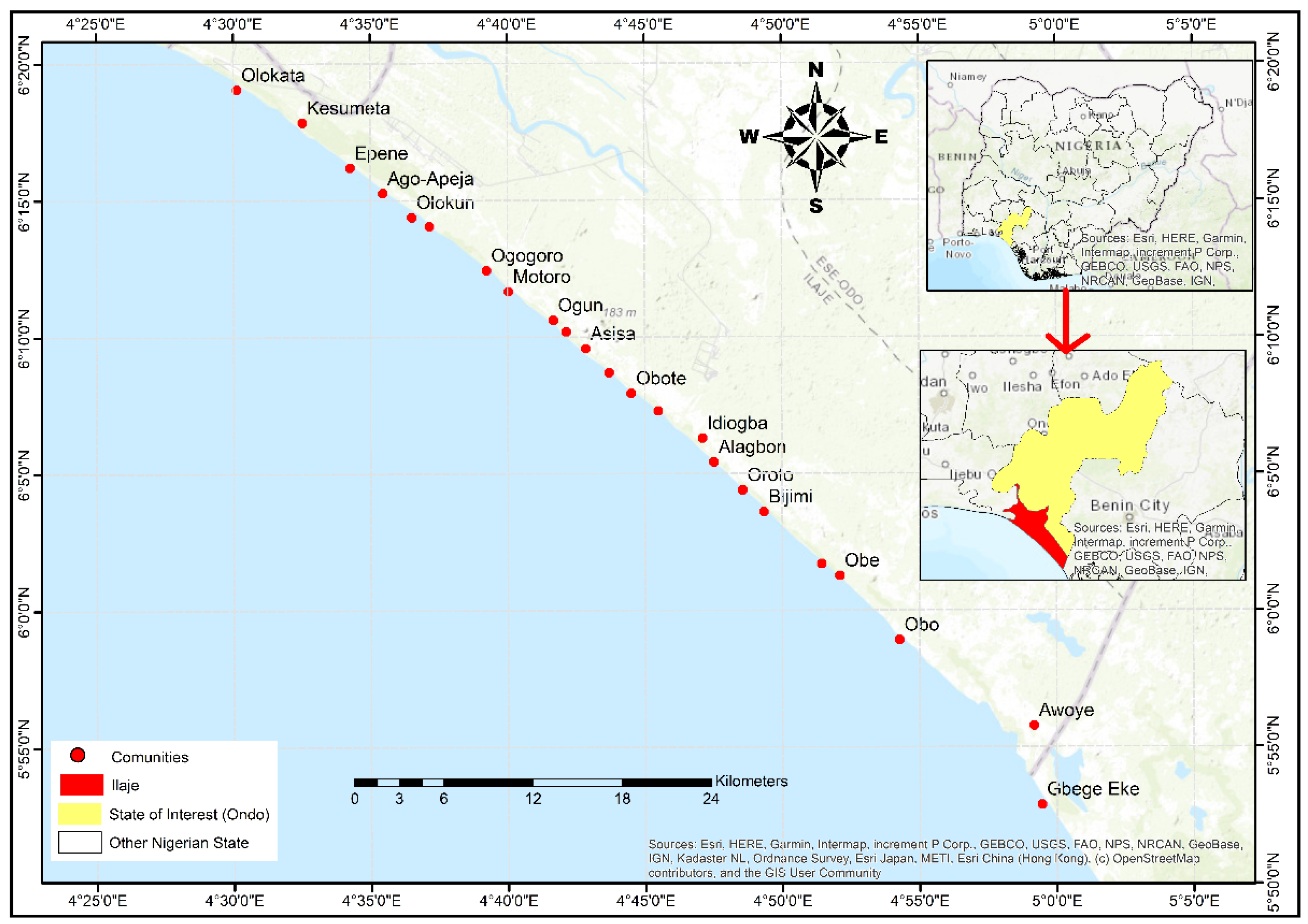
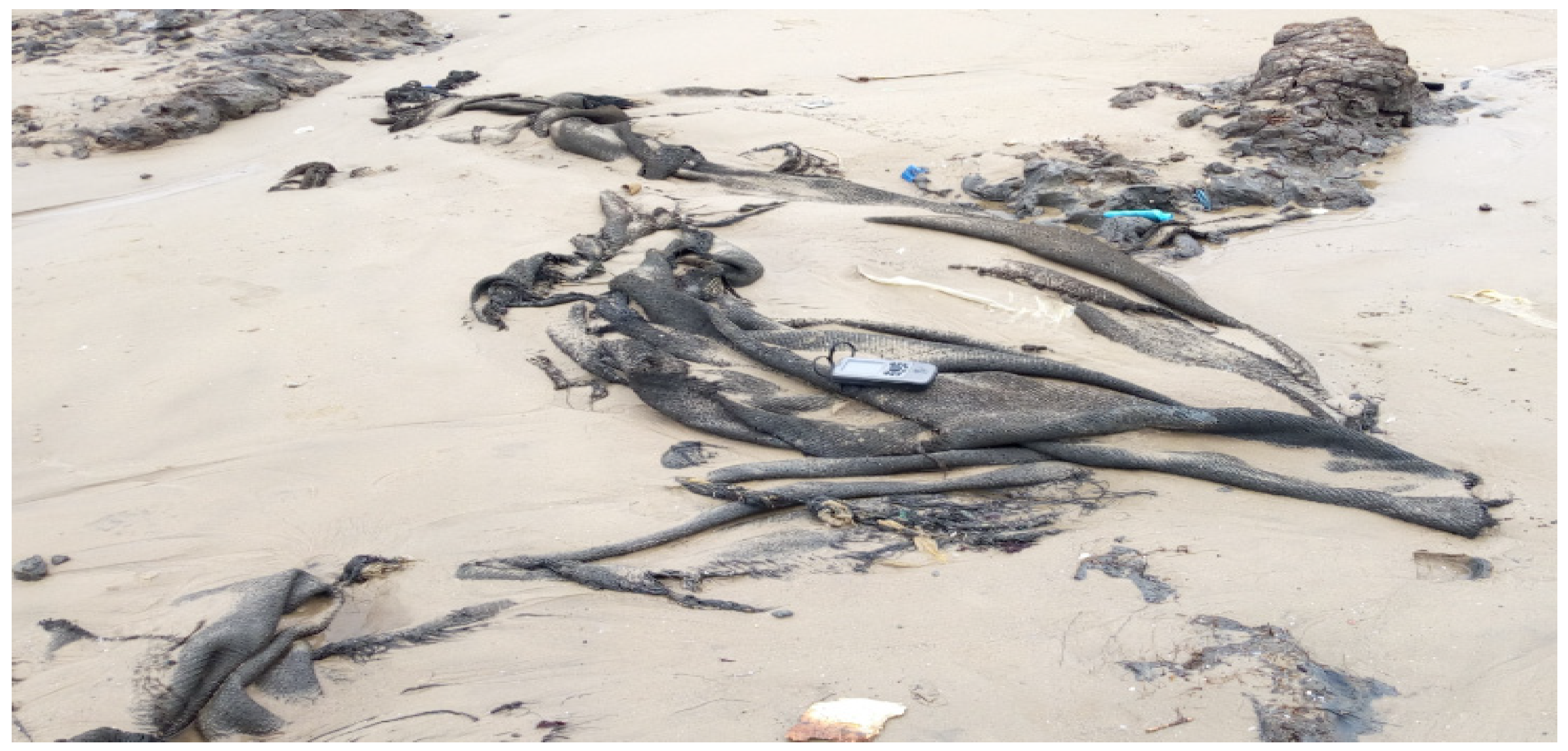
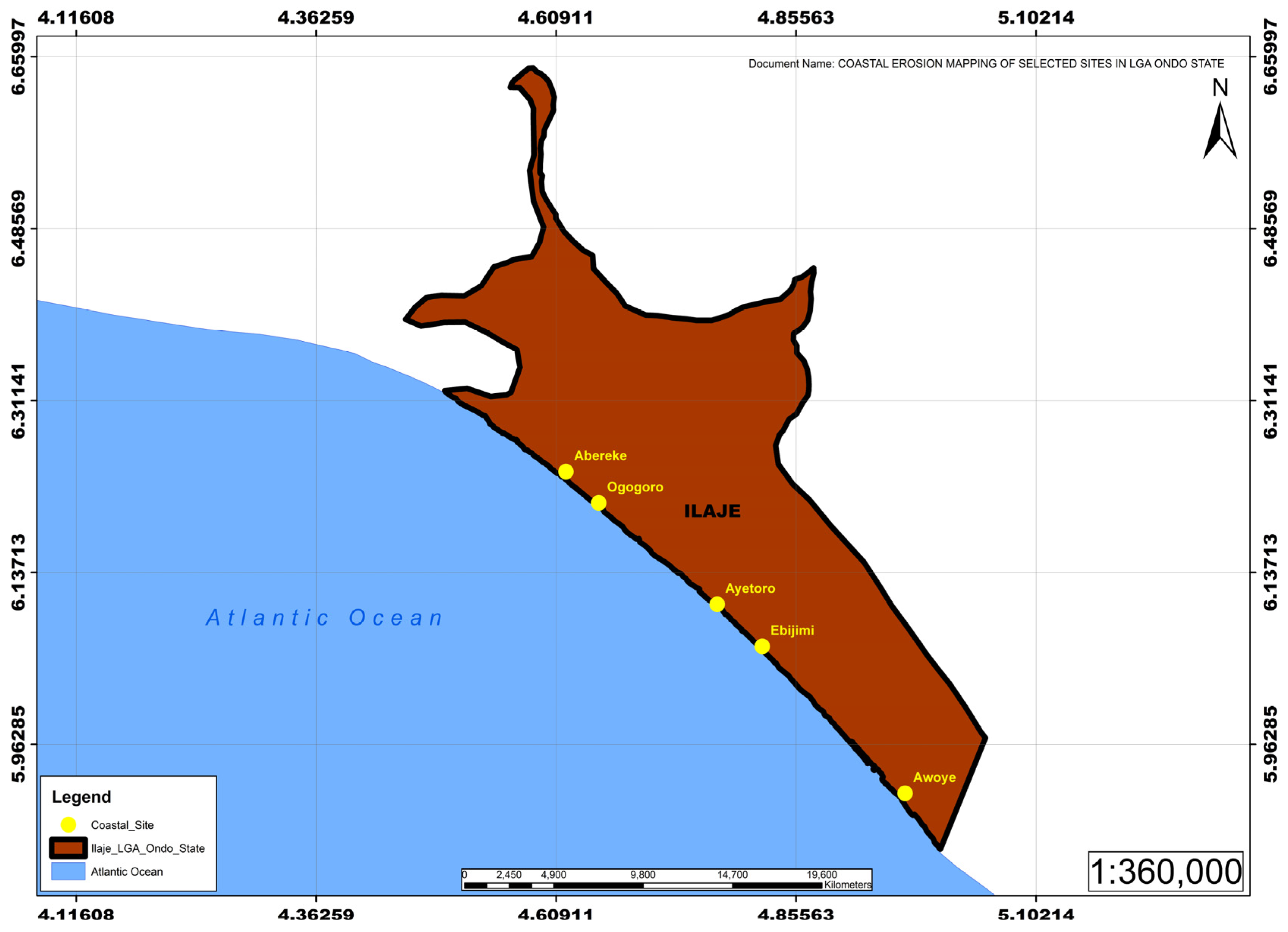

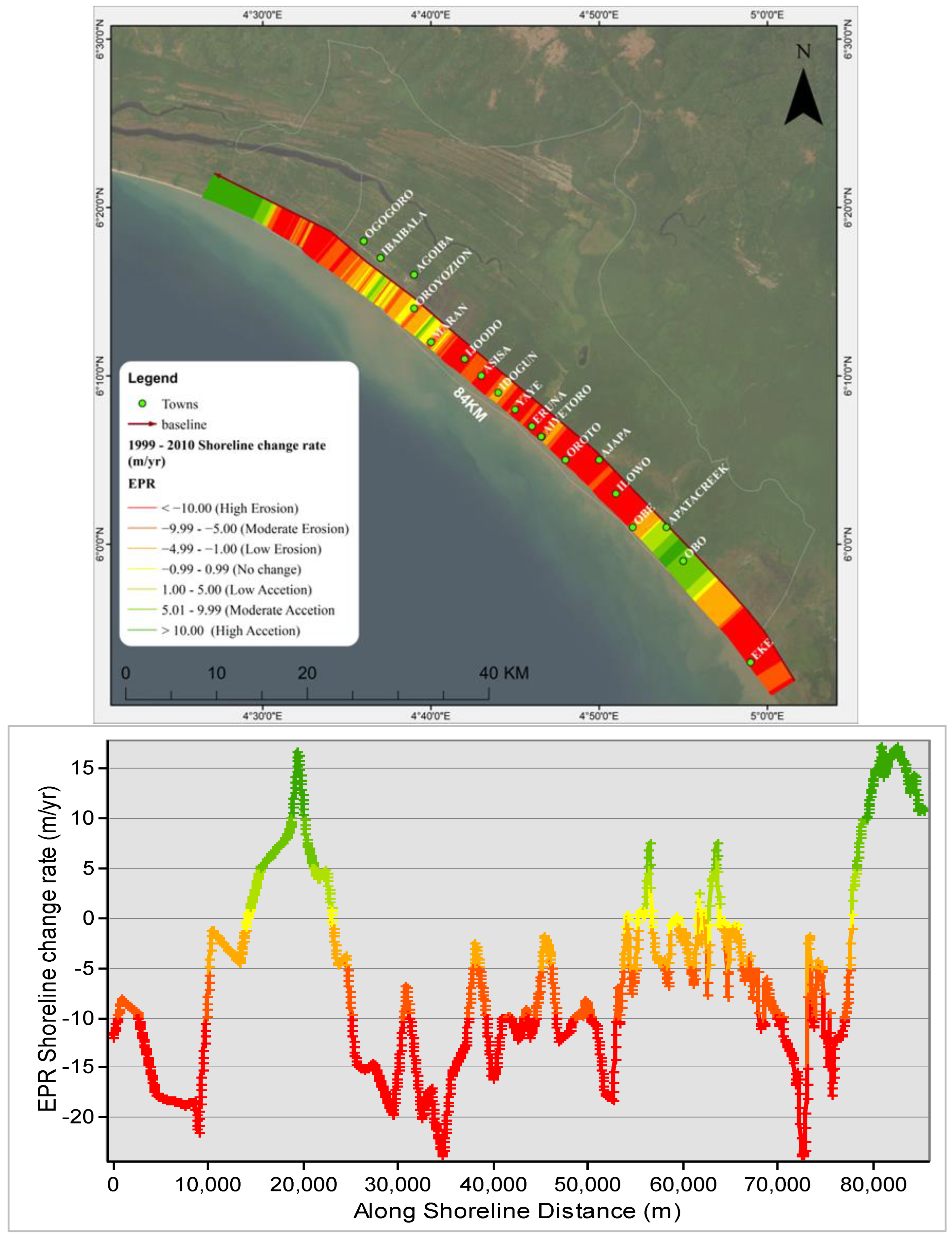
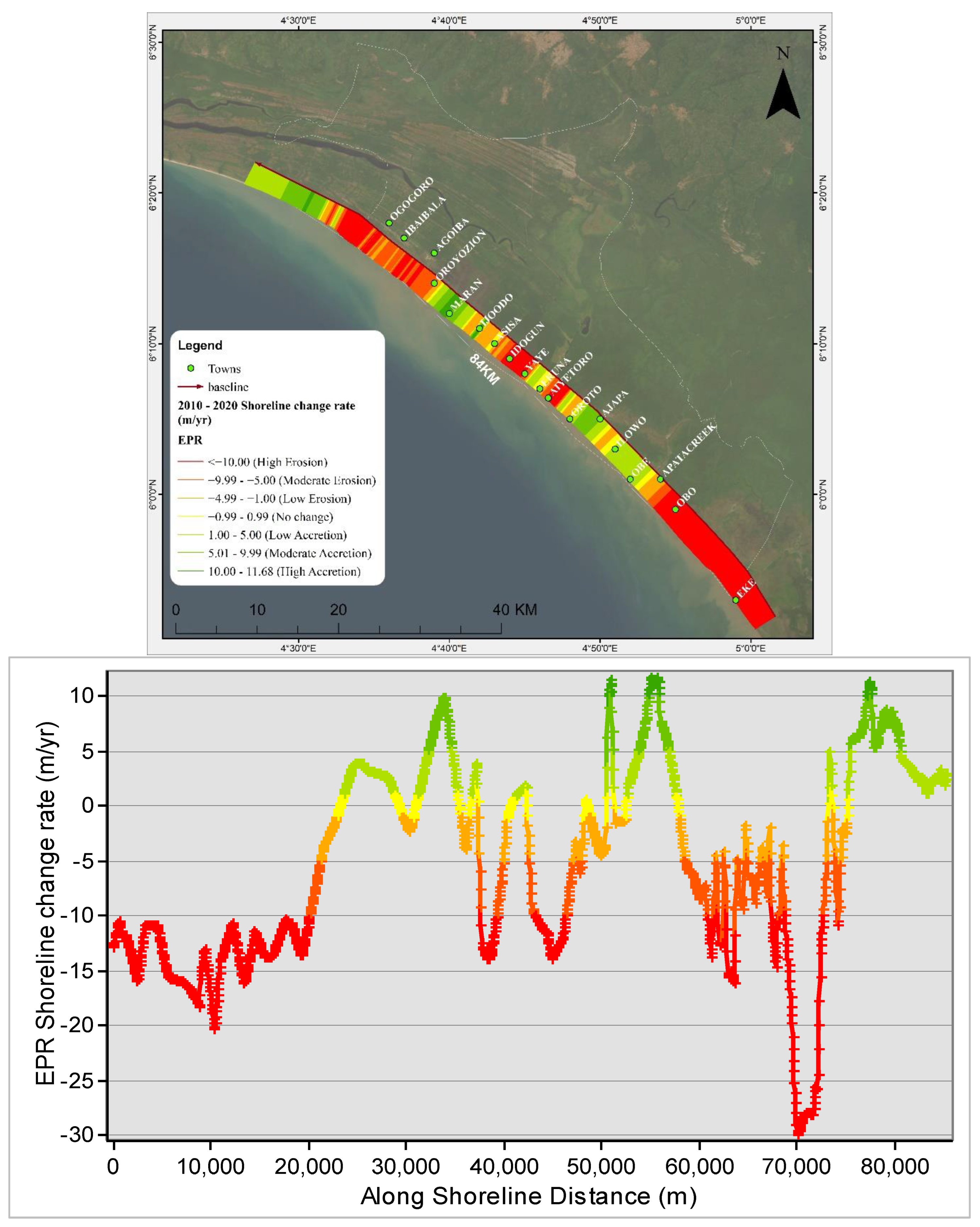

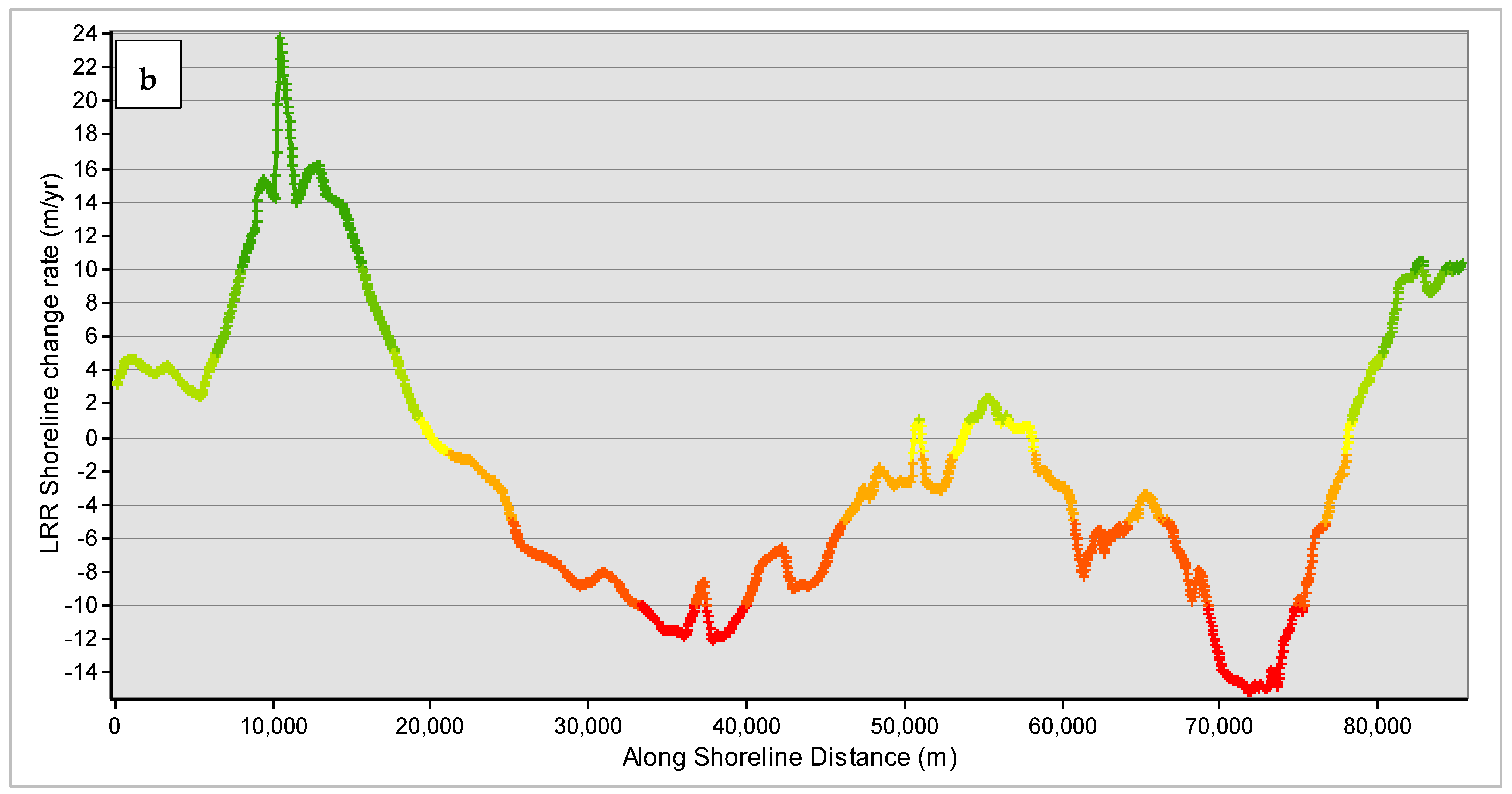
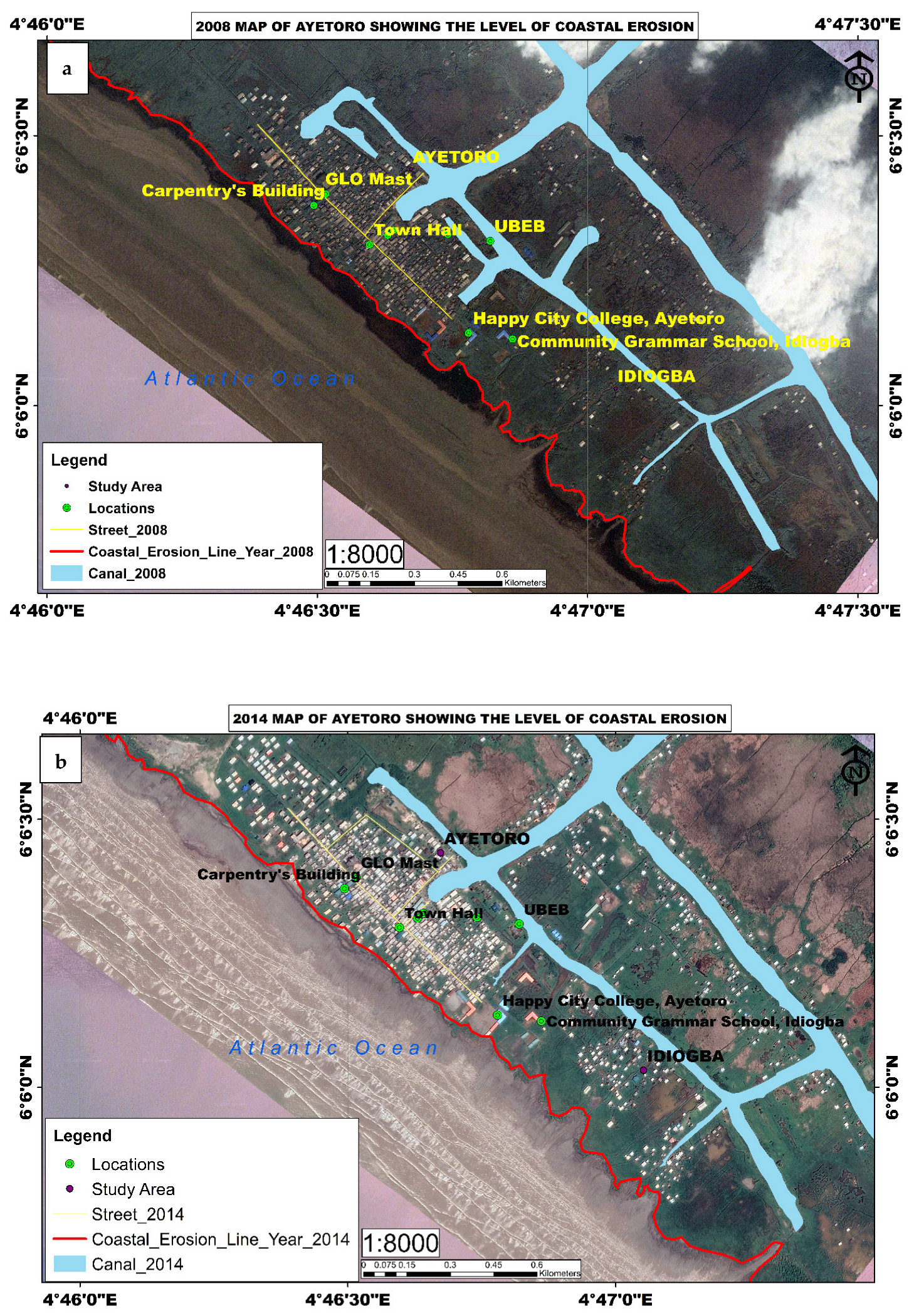

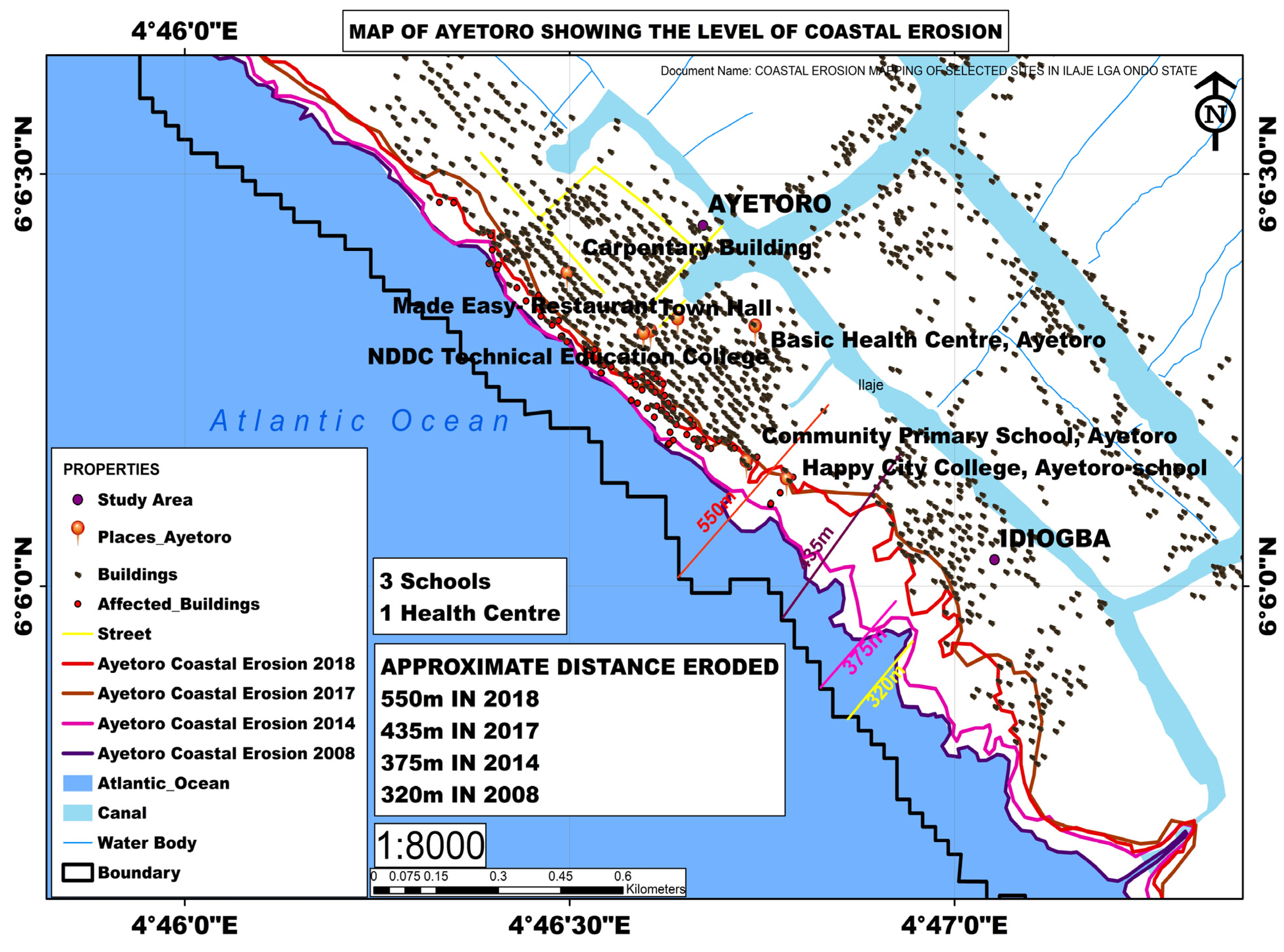


| S/N | Data | Acquisition Date | Resolution in Meters | Data Source |
|---|---|---|---|---|
| 1. | Landsat 5 | 12 December 1986 | 30 | https://developers.google.com/earth-engine/datasets/catalog/landsat-7 |
| 2. | Landsat 7 | 11 December 1999 | 30 | https://developers.google.com/earth-engine/datasets/catalog/landsat-7 |
| 3. | Landsat 7 | 01 December 2010 | 30 | https://developers.google.com/earth-engine/datasets/catalog/landsat-7 |
| 4. | Landsat 8 | 03 December 2020 | 30 | https://developers.google.com/earth-engine/datasets/catalog/landsat-7 |
| EPR (m/y) | LRR (m/y) | ||||
|---|---|---|---|---|---|
| 1986–1999 | 1999–2010 | 2010–2020 | 1986–2020 | 1986–2020 | |
| Total number of transects | 1706 | 1708 | 1708 | 1708 | 1708 |
| Average rate | 5.51 | −6.08 | −5.12 | −1.36 | −1.66 |
| Maximum value erosion | −39.7 | −23.91 | −29.97 | −15.33 | −15.2 |
| Average of all erosional rates | −8.15 | −10.42 | −10.27 | −6.62 | −6.9 |
| Erosion transects, number (%) | 60.14 | 76.81 | 65.16 | 62.54 | 76.23 |
| Accretion transects, number (%) | 39.86 | 23.19 | 34.84 | 37.46 | 23.77 |
| Average of all accretional rates | 26.12 | 8.3 | 4.5 | 8.3 | 7.05 |
| Year | Buildings Submerged | Land Area Submerged (sqm) | Encroachment Length (m) |
|---|---|---|---|
| 2008 | 7 | N/A | N/A |
| Mar 2008–Feb 2014 | 11 | 77,822.331 | 71.31 |
| Mar 2014–Feb 2018 | 64 | 129,882.080 | 84.19 |
| Mar 2018–Feb 2023 | 282 | 202,402.715 | 145.62 |
Disclaimer/Publisher’s Note: The statements, opinions and data contained in all publications are solely those of the individual author(s) and contributor(s) and not of MDPI and/or the editor(s). MDPI and/or the editor(s) disclaim responsibility for any injury to people or property resulting from any ideas, methods, instructions or products referred to in the content. |
© 2023 by the authors. Licensee MDPI, Basel, Switzerland. This article is an open access article distributed under the terms and conditions of the Creative Commons Attribution (CC BY) license (https://creativecommons.org/licenses/by/4.0/).
Share and Cite
Ogunrayi, O.A.; Mattah, P.A.D.; Folorunsho, R.; Jolaiya, E.; Ikuomola, O.J. A Spatio-Temporal Analysis of Shoreline Changes in the Ilaje Coastal Area of Ondo State, Nigeria. J. Mar. Sci. Eng. 2024, 12, 18. https://doi.org/10.3390/jmse12010018
Ogunrayi OA, Mattah PAD, Folorunsho R, Jolaiya E, Ikuomola OJ. A Spatio-Temporal Analysis of Shoreline Changes in the Ilaje Coastal Area of Ondo State, Nigeria. Journal of Marine Science and Engineering. 2024; 12(1):18. https://doi.org/10.3390/jmse12010018
Chicago/Turabian StyleOgunrayi, Olujumoke Adesola, Precious Agbeko Dzorgbe Mattah, Regina Folorunsho, Emmanuel Jolaiya, and Omoniyi John Ikuomola. 2024. "A Spatio-Temporal Analysis of Shoreline Changes in the Ilaje Coastal Area of Ondo State, Nigeria" Journal of Marine Science and Engineering 12, no. 1: 18. https://doi.org/10.3390/jmse12010018






